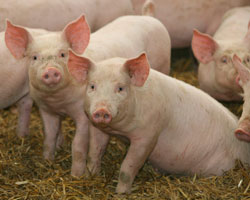New feed particle size analysis method developed
New online publication outlines process for livestock operations and labs.
December 21, 2016

There’s a big difference between coarse grind and fine grind, and when it comes to grinding grain for livestock feed, especially swine, digestibility and efficiency are influenced by how large the grain particles are. Typically, the finer the grind, the better — up to a point.
New research by Kansas State University shows that commercial laboratories and livestock producers who run their own analyses on grain particle size can reduce the time it takes to check a sample from 15 minutes to 10 minutes and get the same result by making a couple of changes to the process.
“Grain accounts for a major component and cost in livestock diets,” said Charles Stark, associate professor in Kansas State’s department of grain science and industry. The particle size of ground grain influences feed digestibility, feed efficiency, how well it mixes and how well it can be pelleted, so periodic particle size evaluation is a necessary part of quality feed manufacturing.
For that reason, Stark and other Kansas State researchers and specialists recommend routine evaluations of the grinding process, whether through a hammer mill or roller mill, to determine grain particle size.
The cost of the equipment needed to run such analyses, however, typically runs $5,000 or more, he said, so most producers send grain samples to commercial laboratories or university labs such as the Kansas State Swine Lab for analysis.
During the analysis process, grain samples go through a stack of sieves, with coarse sieves at the top. As a machine shakes and taps, the grain works its way down through increasingly finer sieves, ultimately to where the sieve opening is smaller than the smallest particle. The small sieves get to particles as small as about 53 microns.
Stark outlined new recommendations based on the research at the recent Kansas State Swine Day 2016 in Manhattan, Kan., and in a new publication, "Evaluating Particle Size of Feedstuffs."
The new recommendations for running feed through a sieve to determine particle size are to use sieve shakers, sieve agitators such as rubber balls or brushes, a dispersing or flow agent such as silicon dioxide and 10 minutes of sieving time.
This is different from what many labs are doing, Stark said, and it has been adopted by the Swine Lab. Until now, the analysis process typically included 10 or 15 minutes of sieving time and often didn’t incorporate sieve agitators or flow agents, but Kansas State’s research indicates that a 10-minute sieving time is sufficient if labs incorporate sieve agitators and a dispersing agent.
Without sieve agitators or a dispersing agent, buildup occurs on the sieves, which keeps grain particles from moving through them and makes the results less accurate than they should be.
The research results showed that 10-minute cycles and 15-minute cycles with the sieve agitators are basically identical, Stark said, so he and other Kansas State specialists believe 10 minutes with the agitators and flow agent will give the result needed.
“With all of the different methods used in the industry and commercial labs, it’s important to know how your lab is conducting the analysis and that adding the agitators and flow agent will significantly reduce the particle result,” Stark said.
More information is available from the Kansas State publication online at www.bookstore.ksre.ksu.edu/pubs/MF3342.pdf.
You May Also Like



